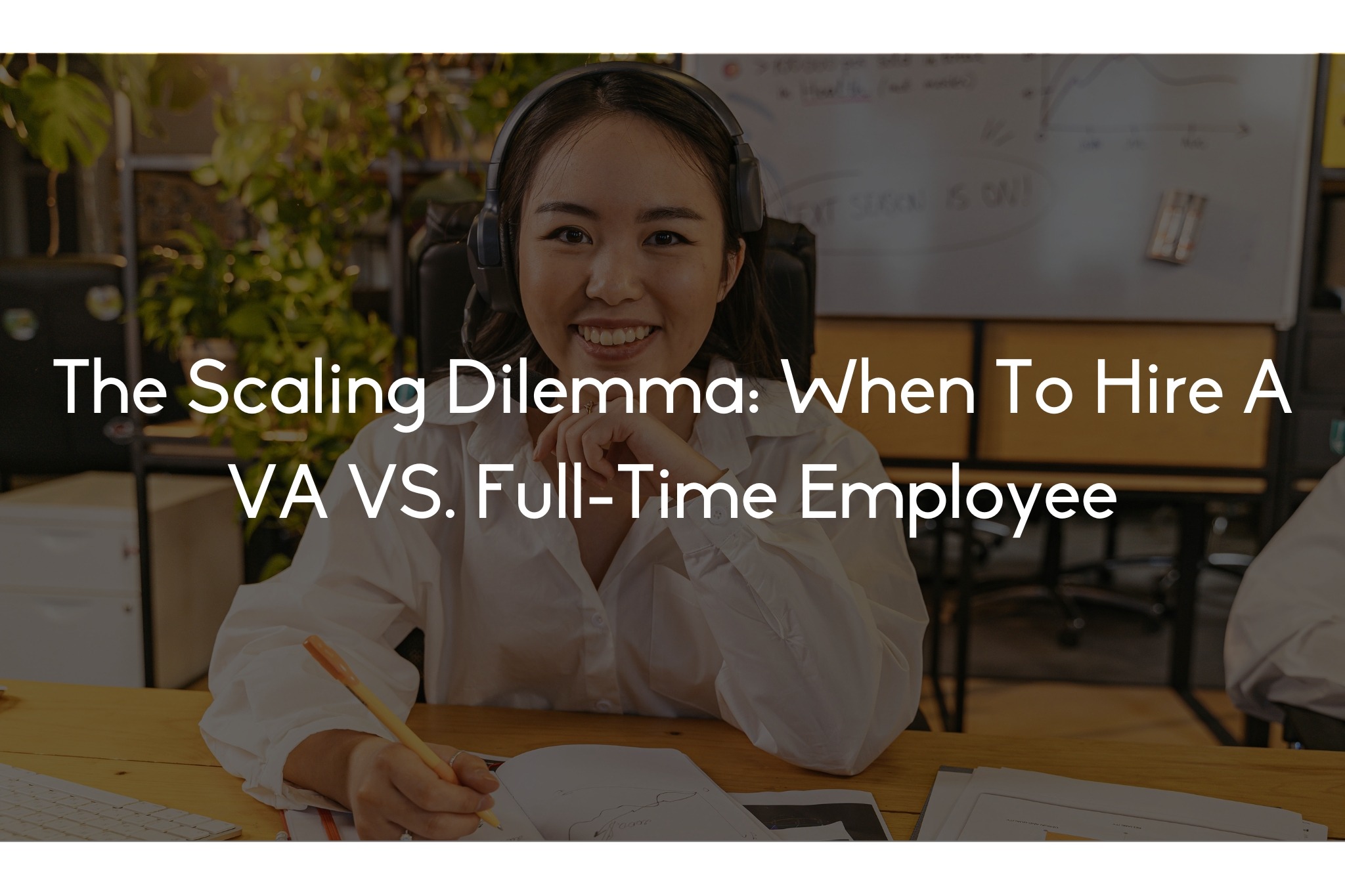

Scaling a small business is a balancing act. Growth brings new challenges, and one of the trickiest is knowing when to build your team—and how. Do you hire a full-time employee? Bring in a virtual assistant (VA)? Both options have advantages, but they serve different stages and strategies in your business journey.
As you hit growth milestones and start feeling the strain—missed deadlines, overflowing inboxes, neglected leads—choosing the right kind of support becomes a critical decision. Make the wrong one, and you may end up with unnecessary overhead or an overwhelmed team. Make the right one, and you’ll unlock new capacity, speed, and profitability.
If your business is growing but still agile, focused on lean operations, and needs flexibility, hire a virtual assistant. If you’re scaling in complexity, need in-house collaboration, or are building long-term internal systems, consider a full-time employee. Many companies thrive by starting with VAs and transitioning to full-time hires as the business matures.
In this article, we’ll break down the key differences between hiring a VA and bringing on a full-time employee. We’ll guide you through when to choose each option based on your goals, budget, and growth strategy—so you’re not just adding people, but adding value.
Hiring a VA from a provider like Katuva starts at $695/month for part-time or $1,350/month for full-time. That’s all-inclusive—no need to worry about health insurance, office space, equipment, or payroll tax. You get a trained, managed professional, ready to plug into your operations.
A U.S.-based employee can easily cost $4,000–$6,000/month when you factor in benefits, onboarding, equipment, and HR compliance. There’s also risk: if they don’t work out, you’re on the hook for severance, unemployment claims, or lost time retraining a replacement.
Rule of Thumb: If your work volume is growing but unpredictable—or if you need to keep expenses variable—a VA gives you room to scale without long-term financial commitments.
With a provider like Katuva, most businesses are matched with a vetted, trained VA in less than two weeks. We handle interviews, screening, and training, so you’re not spending weeks (or months) in hiring limbo.
Hiring a full-time employee often takes 30–60 days, especially for skilled roles. You’re investing time in job postings, interviews, onboarding, and probation periods. There’s more risk if your needs change or if the hire isn’t a good fit.
Choose a VA when: You need someone yesterday to take over tasks like email management, customer service, lead follow-up, or marketing coordination. VAs are a fast-track to freeing your time.
VAs excel at recurring, process-based work. Think inbox triage, CRM updates, social media scheduling, invoice management, research, or even qualifying leads. With clear SOPs in place, a VA can run whole segments of your operations reliably.
When you need someone to make decisions, manage teams, or build out entire business units, a full-time employee often makes more sense. They’re embedded in your company culture, work closely with other departments, and typically carry more strategic responsibility.
Think VA for: Administrative efficiency.
Think employee for: Internal growth leadership.
 Culture and Collaboration
Culture and CollaborationA well-trained VA integrates into your systems, attends regular check-ins, and can even join Slack or Zoom team meetings. While they’re remote, they’re not “disconnected”—especially when supported by a structured partner like Katuva.
When your business needs someone deeply immersed in internal discussions, live brainstorming, or face-to-face meetings, an in-house employee is more embedded. But this benefit only matters if you actually need it—many small teams overestimate how much collaboration really requires physical presence.
Pro Tip: Don’t default to “in-house” if remote works. Instead, ask: Will proximity change the outcome of the work?
If you’re a solo founder, small team, or growing agency, virtual assistants are an ideal first step. They give you the leverage to delegate without taking on long-term liabilities. You can hire 1–3 VAs to offload different parts of your business—sales follow-up, customer support, marketing—without exploding your overhead.
At Katuva, many of our clients are service-based businesses that scaled from 6 to 7 figures using VAs exclusively. Once they cross that threshold, they often blend in a few full-time hires for leadership roles.
Once your business has consistent revenue, multiple departments, and long-term planning cycles, it may be time to invest in full-time staff. Employees often take ownership of strategy, long-term planning, and leadership that VAs aren’t positioned to own.
Growth Path Suggestion:
Katuva doesn’t just place VAs—we manage them. That means structured onboarding, performance reviews, skill-building through VA Ignite, and client check-ins. You’re not alone in managing your VA’s output or growth.
You’re responsible for creating structure, training programs, and handling HR concerns. That’s doable, but it pulls your attention away from growth. You’ll need to set up systems to manage their productivity, development, and well-being.
Where VAs Win: If you don’t have time (or desire) to become an HR department, a managed VA service gives you capacity without complexity.
At Katuva, we help business owners build lean, powerful teams. That often starts with one great virtual assistant—someone who gives you back time, increases your productivity, and helps you move faster toward your goals.
Hiring a full-time employee isn’t wrong—it’s just not always right. Think about your growth horizon: Do you need flexibility or permanence? Agility or structure? Task execution or strategy development?
Here’s the truth: You don’t have to choose one or the other. Many of the fastest-growing companies we serve use a hybrid model—leaning on VAs for day-to-day execution and layering in full-time hires as their core team grows.
The real question isn’t VA vs. employee. It’s: What will move your business forward right now—with the least friction and most return?
